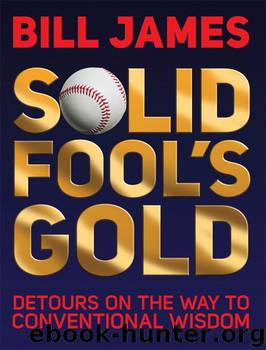Solid Fool's Gold by Bill James

Author:Bill James [James, Bill]
Language: eng
Format: epub
ISBN: 9780879466084
Publisher: ACTA Publications
Published: 2011-05-20T04:00:00+00:00
HOT PITCHERS
by Bill James
If a starting pitcher has been pitching well in his recent starts, is he more likely to pitch well today? It is hard to believe that he isn’t, isn’t it? If a pitcher has pitched shutout baseball in three of his last four starts, don’t you have to believe that he’s more likely to pitch well than if he’s been getting beat up?
A pitcher being “hot” is a little different than a hitter being hot. A hitter being hot…what is that? Self-confidence? Karma? Extra batting practice? A new titanium necklace? A pitcher can be hot or cold for meaningful and apparent reasons—minor injuries, arm fatigue, a new pitch that’s working for him that the league hasn’t figured out yet.
I have done three new studies to try to figure out whether a “hot” starting pitcher is more likely to pitch well, in his next start, than a pitcher who has not been pitching well. In the first of those studies, what we will call the Bob Gibson Study, I studied the performance of “hot” pitchers versus the performance of equally good pitchers who were not hot. In the second study, which we will call the A. J. Burnett/Josh Beckett study, I studied the question of whether there was any tendency for good games and bad games to form clusters. My third study compared pitchers with identical or near-identical year-to-date records, but one of whom came into the start hotter than the other. I call this the Matched-Set Study.
I. THE BOB GIBSON STUDY
I took all pitchers from the years 1960 to 1969, and divided them into two groups, twice. The first division was among pitchers as to the quality of the season’s performance. I ranked all pitchers by the Season’s Score, and then divided them into eight groups with (essentially) equal numbers of games started in each group. There were 31,730 Games Started in major league baseball from 1960 to 1969, so that’s about 4,000 starts in each group.
Then I divided the 4,000 starts in each set into eight groups, separated by how “hot” the pitcher was coming into the game.
The highest quality pitchers, coming into the game red hot, would be group AA. The highest quality pitchers, coming into the game having been pitching very badly, would be group AH.
The lowest quality pitchers, coming into the game having been pitching very badly, would be group HH. The lowest quality pitchers, coming into the game pitching very well, would be group HA.
There were 64 groups of starting pitchers, with about 500 starts in each group.
This is coloratura, but you may be wondering who is an “A” quality starting pitcher, who is a “B”, etc. The Season Score is based on the pitcher’s Wins, Losses, Innings Pitched, ERA, Strikeouts and Walks, and also on Saves if there are any. Here is a chart of randomly selected “A”, “B”, “C”, pitchers, etc., which should give you a sense of what kind of pitcher we are dealing with in each group.
Download
This site does not store any files on its server. We only index and link to content provided by other sites. Please contact the content providers to delete copyright contents if any and email us, we'll remove relevant links or contents immediately.
Machine Learning at Scale with H2O by Gregory Keys | David Whiting(3658)
Never by Ken Follett(3547)
Liar's Poker by Michael Lewis(3230)
The Ultimate Backcountry Survival Manual by Aram Von Benedikt; Editors of Outdoor Life;(3173)
Will by Will Smith(2591)
The Partner by John Grisham(2286)
Friends, Lovers, and the Big Terrible Thing by Matthew Perry(2016)
Can't Hurt Me: Master Your Mind and Defy the Odds - Clean Edition by David Goggins(2010)
Taste by Kris Bryant(1806)
HBR's 10 Must Reads 2022 by Harvard Business Review(1702)
A Short History of War by Jeremy Black(1677)
Never Finished: Unshackle Your Mind and Win the War Within by David Goggins(1563)
The Arm by Jeff Passan(1528)
515945210 by Unknown(1524)
The Dodgers by Schiavone Michael;(1479)
The Yogi Book by Yogi Berra(1426)
443319537 by Unknown(1400)
A Game of Thrones (The Illustrated Edition) by George R. R. Martin(1377)
Road Games by Road Games(1373)
